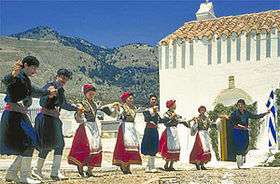Sacred dance
Sacred dance is the use of dance in religious ceremonies and rituals, present in most religions throughout history and prehistory. Its connection with the human body and fertility has caused it to be forbidden by some religions; for example, its acceptability in Christianity has varied widely. Dance has formed a major element of worship in Hindu temples, with strictly formalized styles such as Bharatanatyam, which require skilled dancers and temple musicians. In the 20th century, sacred dance has been revived by choreographers such as Bernhard Wosien as a means of developing community spirit.[1]
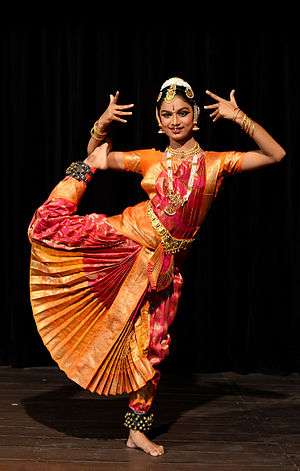
Purposes
The theologian W. O. E. Oesterley proposed in 1923 that sacred dance had several purposes, the most important being to honour supernatural powers; the other purposes were to "show off" before the powers; to unite the dancer with a supernatural power, as in the dances for the Greek goddesses Demeter and Persephone;[2] making the body suitable as a temporary dwelling-place for the deity, by dancing ecstatically to unconsciousness; making crops grow, or helping or encouraging the deity to make them grow, as with Ariadne's Dance as described in the Iliad;[3][4] consecrating a victim for sacrifice (as with the Israelites circling the altar, or the Sarawak Kayans circling a sacrificial pig); paying homage to the deity present for an initiation ceremony; helping warriors to victory in battle, and appeasing the spirits of the enemy killed in battle; averting the dangers associated with marriage, at a wedding ceremony; and at a funeral or mourning ceremony, purposes such as driving away the malevolent ghost of the dead person, or preventing the ghost from leaving the grave, or frightening off any evil spirits attracted by the corpse, or temporarily and invisibly bringing the dead person back to join in the dance, or simply honouring the dead person.[4]
The dancer and scholar Harriet Lihs in 2009 divided religious dance into dances of imitation, such as of animals thought to be spirit messengers, or of battles; "medicine dances", i.e. dances of healing, like the serpent dances in India used to prevent disease; commemorative dances, for events such as the winter solstice; and dances for spiritual connection, as in the whirling dance of the Whirling Dervishes within Sufism.[5]
Laura Shannon, a teacher of sacred dance for women,[6] in 2018 stated the purposes of contemporary sacred dance as practised at the Findhorn Foundation as "to be inclusive, mutually supportive, to connect with the earth, spirit and each other, and to become more whole." It was a means of channelling "healing energy" both for the dancers and for their families and communities, indeed for the whole world.[7]
Within religion, ecstatic dance is one of the ways in which religious ecstasy is produced.[8]
In ancient times
Indigenous ceremonial dance rituals around the world appear to preserve forms that were widespread in ancient times. For example, processionals and circle dances seen in indigenous dance today were used in ancient Egypt and among the Hebrews.[9] In ancient Egypt, dancers impersonated a deity such as the goddess Hathor, taking on the deity's attributes and interpreting the divine world for those watching.[10]
In ancient Israel, King David danced "before the Lord".[11][10] It is mentioned as something familiar, implying it was a common practice.[12] Sacred dance is described in the Bible by verbs meaning dancing, rotating, jumping, skipping, and whirling.[13] The dance was accompanied by hand-drums (tambourines), cymbals, flutes, pipes, lyres, harps, and lutes.[14]
The Hittites are shown in a sacred processional dance in a c. 1200 BC rock inscription at the sanctuary of Yazılıkaya, near their city of Hattusa, in Cappadocia. A group of men wearing conical hats and tip-tilted shoes, and a group of women, dance in a running step towards a group of named gods and goddesses.[15]
In ancient Greece, sacred dance was widespread; indeed, it formed a part of almost all worship, and the gods Apollo, Ares, Dionysus and Pan are all described as dancers, while other deities such as Artemis were described as dancing with their companions.[16]
The Hawaiian Hula dances to Pele, the volcano goddess, survive, whereas European maypole dances have lost their meaning as tree-worship and survive only as folk tradition.[9]
Lewis Farnell, an anthropologist, observed that sacred dance has an "extraordinary uniformity" among indigenous peoples all over the world, something that he found so striking that it suggested either "belief in an ultimately identical tradition, or, perhaps more reasonably, the psychologic theory that ... [humans] at the same stage of development respond with the same ... religious act to the same stimuli" from the environment.[17] Oesterley suggested that these stimuli to sacred dance were people's response to supernatural power, and "the obtaining of food."[18]
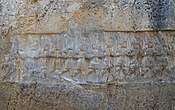
- Dancers in ancient Egypt. Tomb of the Dancers, 17th Dynasty, Thebes. 5th or 4th century BC
 Dancer at festival of Apollo Karneios, wearing kalatiskos straw hat. 5th century BC
Dancer at festival of Apollo Karneios, wearing kalatiskos straw hat. 5th century BC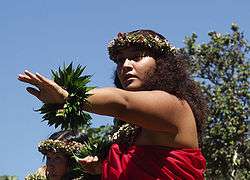
_04.jpg)
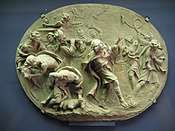 King David dancing before the Ark. Italian terracotta, c. 1660
King David dancing before the Ark. Italian terracotta, c. 1660
In world religions
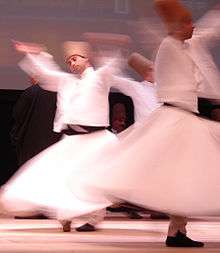
Christianity
Some Christian traditions make use of liturgical or worship dance, but it has long been controversial within the church.[10] It has been supported, sometimes fervently, by both priests and Christian scholars; and opposed, sometimes stridently, by others who for example wrote some 157 tracts against dance between 1685 and 1963. The early church was largely in favour of dance, as in the 2nd century AD Acts of John which states that "Grace danceth. I would pipe: dance ye all. The whole world on high hath part in our dancing."[19][20] Circle dance is used, in its more meditative form, in worship within religious traditions including the Church of England.[21][22][23] In northern Greece and southern Bulgaria, in the annual celebrations for Saint Constantine and Saint Helen, dancers perform the Anastenaria, a fire-walking ritual, as the climax of three days of processions, music, dancing, and animal sacrifice.[24][25][26]
Hinduism
Indian classical dances such as Bharatanatyam, Kathak, Odissi, and Mohiniattam can be traced to the Sanskrit text Natya Shastra.[27][28] They are a traditional drama-dance expression of religion,[29] related to Vaishnavism, Shaivism, Shaktism, pan-Hindu epics and the Vedic literature.[30] As a religious art, they are either performed inside the sanctum of a Hindu temple, or near it.[31][32]
Islam and Sufism
Dance is unusual within Islam, but circle dance is used in the Islamic Haḍra dances.[23] In the tradition of the Mevlevi Order founded by Rumi, ecstatic Sufi whirling is practised by devotees as a form of active meditation within the Sama (worship ceremony).[33][34] In 2007, Sufi practices including ecstatic dance and the reciting of religious poetry were a focus for political resistance in Iran, reportedly "demoniz[ed]" by Shi'a clerics.[35]
Syncretic
The syncretic Afro-American religious tradition Candomblé, practiced mainly in Brazil, makes use of music and ecstatic dance in which worshippers become possessed by their own tutelary deities, Orishas.[36]
Spiritual and New Age
.jpg)
The mystic and spiritual teacher George Gurdjieff collected or authored a series of sacred dances, known as Gurdjieff movements, and taught them to his students as part of what he considered the work of "self observation" and "self study".[38]
The Dances of Universal Peace, created in the 1960s by North American Sufis, use dancing, Sufi whirling, and singing of sacred phrases from different religions to raise consciousness and promote peace between diverse religions.[39][40]
From 1976, the ballet master and choreographer Bernhard Wosien introduced circle dance at the Findhorn Foundation in Scotland. He used both traditional dances and his own choreography to develop "group awareness".[41] Wosien's approach was taken up by the dance teacher Anna Barton, both at Findhorn and across Europe in the 1980s, and this style of sacred dance spread around the world.[7]
In Western art
Choreographers starting with Isadora Duncan, Ruth St. Denis and her husband Ted Shawn, and Martha Graham developed contemporary dance early in the 20th century, often using elements of sacred dance and fusing them with other genres. Later choreographers also made use of themes from the Bible.[42][43]
References
- Gaston, Anne-Marie (Anjali); Gaston, Tony (1 February 2014). "Dance as a Way of Being Religious". In Brown, Frank Burch (ed.). Oxford Handbooks Online. Oxford University Press. doi:10.1093/oxfordhb/9780195176674.013.010.
- Lawler, Lillian Brady (March 1947). "The Dance in Ancient Greece". The Classical Journal. 42 (6): 343–349. JSTOR 291645.
- Homer. The Iliad. pp. 18: 590–606.
- Oesterley 2010, pp. 22–30 and passim
- Lihs 2009, pp. 6–7.
- Shannon 2016.
- Shannon, Laura (30 May 2018). "Sacred Dance, Armenian Dance". Findhorn Foundation. Retrieved 3 November 2018.
- Ulland, Dagfinn (1 January 2012). "Embodied Spirituality". Archive for the Psychology of Religion. 34 (1): 83–104. doi:10.1163/157361212x645340.
- Lihs 2009, pp. 7–8.
- Mark, Joshua J. "Music & Dance in Ancient Egypt". Ancient History Encyclopedia. Retrieved 4 November 2018.
- 2 Samuel 6:5
- Oesterley 2010, p. 37.
- Oesterley 2010, pp. 44–53.
- Oesterley 2010, pp. 52.
- Oesterley 2010, p. 59.
- Oesterley 2010, pp. 64, 68.
- Farnell, Lewis Richard (2009) [2005]. The Evolution of Religion | An Anthropological Study. Cornell University Library. p. 2. ISBN 978-1112156984.
- Oesterley 2010, pp. 2–3.
- Lihs 2009, pp. 14–16.
- Wosien 1974, p. 28.
- "We ended with a circle dance." "A short session of circle dance was one of the activities on offer...""St. James's Church, Piccadilly Annual Report 2006/2007" (PDF). Archived from the original (PDF) on 14 February 2012. Retrieved 24 February 2013.
- "...we were able to testify our love to the lord using circle dance and hymn singing."
- Shiloah, Amnon (2001). Music in the World of Islam: A Socio-Cultural Study. Wayne State University Press. p. 143. ISBN 0-8143-2970-5.
- Xygalatas, Dimitris (2007). Joseph Bulbulia; Richard Sosis; Erica Harris; Russell Genet; Cheryl Genet; Karen Wyman (eds.). Firewalking and the Brain: The Physiology of High-Arousal Rituals. Evolution of Religion: Studies, Theories, and Critiques. Collins Foundation Press. pp. 189–195.
- Xygalatas, Dimitris (2011). "Ethnography, Historiography, and the Making of History in the Tradition of the Anastenaria" (PDF). History and Anthropology. 22 (1): 57–74. doi:10.1080/02757206.2011.546855.
- Danforth, Loring M. (1989). Firewalking and Religious Healing: The Anastenaria of Greece and the American Firewalking Movement. Princeton University Press. ISBN 978-0691028538.
- Lochtefeld, James G. (2002). The Illustrated Encyclopedia of Hinduism: N-Z. The Rosen Publishing Group. pp. 467. ISBN 978-0-8239-3180-4.
the Natyashastra remains the ultimate authority for any dance form that claims to be 'classical' dance, rather than 'folk' dance.
- Khokar, Mohan (1984). Traditions of Indian classical dance. Clarion Books. pp. 57–58.
- Brown, Frank Burch, ed. (2013). The Oxford Handbook of Religion and the Arts. Oxford University Press. pp. 195–196. ISBN 978-0-19-972103-0.
All of the dances considered to be part of the Indian classical canon (Bharata Natyam, Chhau, Kathak, Kathakali, Manipuri, Mohiniattam, Odissi, Sattriya and Yakshagana) trace their roots to religious practices (...) the Indian diaspora has led to the translocation of Hindu dances to Europe, North America and the world.
- Devi, Ragini (1990). Dance Dialects of India. Motilal Banarsidass. pp. 25-30, 67–68, 166. ISBN 978-81-208-0674-0.
- Lipner, Julius (2012). Hindus: Their Religious Beliefs and Practices. Routledge. p. 206. ISBN 978-1-135-24061-5.
Hindu classical dance... developed in a religious context and was given high profile as part of temple worship. There are a number of regional and other styles as well as source texts, but the point we wish to stress is the participative nature of such dance. In form and content, the heart of dance as worship in Hinduism has always been 'expression' (abhinaya), i.e. the enacting of various themes.
- Holm, Jean; Bowker, John (1994). Worship. Bloomsbury. p. 85. ISBN 978-1-85567-111-9.
Hindu classical dance-forms, like Hindu music, are associated with worship. References to dance and music are found in the vedic literature...
- Erzen, Jale (2008). "The Dervishes Dance -- The Sacred Ritual of Love". Contemporary Aesthetics. 6. hdl:2027/spo.7523862.0006.007.
ecstatic
- "The Sema of the Mevlevi". Mevlevi Order of America. Archived from the original on 21 December 2012. Retrieved 26 March 2009.
- Scolieri, Paul (2008). "Introduction Global/Mobile: Re-orienting Dance and Migration Studies". Dance Research Journal. 40 (2 (Winter)): XVII. doi:10.1017/S0149767700000346.
- "Religions - Candomblé: Candomblé at glance". BBC. 15 September 2009. Retrieved 7 January 2014.
- Bernstein, Matthew; Studlar, Gaylyn (1997). Visions of the East: Orientalism in Film. I.B.Tauris. p. 134. ISBN 978-1-86064-305-7.
- "Introduction". Gurdjieff Dances. Retrieved 28 October 2018.
- "About The Dances of Universal Peace". Dances of Universal Peace. Retrieved 28 October 2018.
- Lihs 2009, p. 17.
- Watts 2006, pp. 6–10.
- "About Sacred Dance". Sacred Dance Guild. Retrieved 28 October 2018.
- Clemente, Karen (2008). "The Sacred or the Profane: The Challenge of Modern Dance in Religious Educational Settings". Journal of Dance Education. 8 (2): 62–72. doi:10.1080/15290824.2008.10387360.
Bibliography
- Lihs, Harriet (2009). Chapter 2 | Dance and Religion. Appreciating dance : a guide to the world's liveliest art (4th ed.). Princeton Book Company. pp. 6–17. ISBN 978-0-87127-318-5. OCLC 316057759.
- Oesterley, William Oscar Emil (2010) [1923]. The Sacred Dance: A Study in Comparative Folklore. Kessinger. ISBN 978-1163177228.
- Roth, Gabrielle. Sweat Your Prayers: Movement as Spiritual Practice. Newleaf, 1999.
- Shannon, Laura, ed. (2016). String of Pearls : celebrating 40 years of sacred dance in the Findhorn Community. Sarsen Press. ISBN 978-0-9934358-5-0. OCLC 1001307546.
- Stewart, Iris J. Sacred Woman, Sacred Dance: Awakening Spirituality Through Dance and Ritual. Inner Traditions, 1997. Review
- Watts, June (2006). Circle Dancing: Celebrating Sacred Dance. Green Magic. ISBN 978-0-9547230-8-8.
- Winton-Henry, Cynthia. Dance - The Sacred Art: The Joy of Movement as a Spiritual Practice. Skylight Paths Publishing, 2009.
- Wosien, Maria-Gabriele (1974). Sacred Dance: Encounter with the Gods. Thames and Hudson. ISBN 0-500-81006-0.
- Zehr, Leslie. The Alchemy of Dance: Sacred Dance as a Path to the Universal Dancer. iUniverse, 2008.
